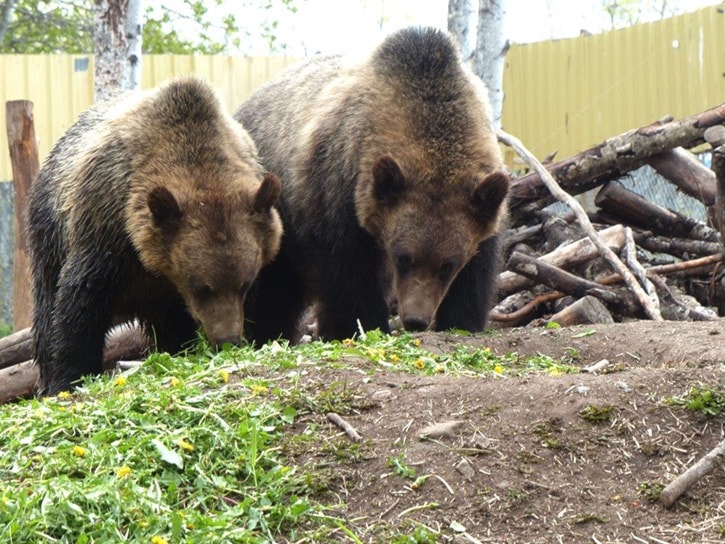We’re talking bears; yes, it’s that time. Our hairy neighbours are up and roaming about on the lookout for food again, and two are about to return to the land they knew as young cubs.
Last summer, a grizzly sow and her two cubs were spotted in several local backyards browsing for something to eat. The bears had gotten too close for comfort, and their wandering ended tragically with the mother being killed.
Fortunately for the two orphans, a pilot program run out of the Northern Lights Wildlife Society in Smithers, B.C. is rehabilitating grizzly cubs for reintegration into nature. The Society, which has been running rehab programs for black bears for decades, began their grizzly project in 2007 with two orphan grizzlies out of Prince George. With this pair from the area, they have now had eight of the bears through their program.
Like many rehabilitation programs, the Northern Lights one has its skeptics, including the provincial government who originally said no they would not participate in the project, said Angelika Langen, one of the society’s two founders. But persistence paid off, and with grizzly bear numbers dwindling in the province, the government relented.
“I can be a real pain in the butt and they got tired of me,” said a smiling Langen at a meeting in Nakusp about the upcoming release of the two bears. The rehab facilitator had come to town to talk about the program and discuss any issues that residents have with bears.
“We want to know what the problems are,” said Langen, who stated her commitment to helping keep the peace between the species. Prevention is critical, she said, with securing food sources away from bear as necessary for the safety of bears, people and other animals (dogs, cats, livestock). Electricity works incredibly well, for instance, with few bears willing to get a second dose of the stuff.
The two cubs coming back to the area were the first to experience the use of electricity in their course of rehab. Not your typical course of treatment in rehab, at least not in your typical human rehab centre.
Rehabilitating grizzlies is a relatively new idea, although black bear rehab has been around for a while. In either case, the goal is to get the critters to be able to survive in the wild on their own and not to become a nuisance to human critters.
But it’s not all shock and awe. Like all creatures, bears need love too, especially when they’re less than a year old, so Langen became the mother figure for the cubs in their 8,000 square foot enclosure during their time in the facility. She nurtured them, but the bears were also taught to avoid humans later on with negative contact, which can be daunting for the rehab facilitators.
The one thing humans can’t do is train the cubs to avoid adult males, the biggest animal threat to their lives. Boars can see the young bears as food, and the Langens have had adult bears try to break into the enclosures. Metal fencing buried four feet down and in under the pen’s ground stops bears breaking either in or out.
But the physical barriers are secondary to the actual rehabilitation process.
“It’s very hard to rehabilitate a bear,” Langen told the Arrow Lakes News. “It depends on the personality of the individual, just like people.” But it is far from impossible to do: Northern Lights hasn’t had a single problem bear come out of its rehab program.
A recidivism rate of zero speaks volumes for the program, and Langen is very clear that offender bears give all bears a bad name.
“We would euthanize problem bears because it’s not worth it,” she said. “We haven’t done it yet, but we would in a heartbeat.” The bad rap one bothersome bear could create for all of bearkind is just not worth it, Langen emphasized.
But many people don’t understand that they could be creating problem bears by feeding them either intentionally or unintentionally by not protecting their livestock or keeping food sources like garbage or unpicked fruit out of reach of bears. Once bears have had a taste of easy food, they’ll keep coming back for more, creating a hazard for humans and bears.
Cubs who are rehabilitated are released back in their original habitat as far from human populations as possible. They carry souvenirs from their trip to rehab: an ear tattoo, a microchip and a radio collar that will collect data over 18 months until the batteries run out and it automatically falls off.
Just like people, grizzly cubs have complex familial relationships. Watching the bears in the rehab pen and then tracking the bears over the year and a half, the Langens have seen two brothers who fought all the way through their time in the facility and then head in different directions as soon as they were released. Another pair, Drew and Jason, stuck together so closely that it was hard to separate the tracking signals from their collars.
How the two orphans from our area choose to travel will be seen once they are released this Tuesday, June 18. With luck they will follow the bears before them and live happy lives back in the wild far away from their funny hairless human animal neighbours.
